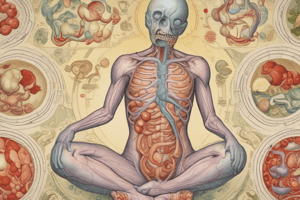Podcast
Questions and Answers
What role does CCK primarily play in the regulation of appetite?
What role does CCK primarily play in the regulation of appetite?
- Increases the level of blood glucose
- Converts proteins into glucose
- Stimulates the breakdown of glycogen
- Communicates with the brain to signal fullness (correct)
How does glucagon primarily exert its satiating effects?
How does glucagon primarily exert its satiating effects?
- Through binding to receptors in the pancreas
- By affecting glycogen stores in the liver (correct)
- Through a direct connection to the hypothalamus
- By directly increasing appetite
Which statement best describes the relationship between food characteristics and feelings of satiety?
Which statement best describes the relationship between food characteristics and feelings of satiety?
- Texture has no significant impact on food intake.
- Both nutrient type and texture can affect hunger and satiety. (correct)
- Soft foods are more satiating than solid foods due to their nutrient composition.
- Only caloric density influences feelings of fullness.
When does glucagon typically start to impact food intake?
When does glucagon typically start to impact food intake?
What happens to appetite regulation when glucagon receptors in the liver are damaged?
What happens to appetite regulation when glucagon receptors in the liver are damaged?
What role does glucose metabolism in the hypothalamus play in energy regulation?
What role does glucose metabolism in the hypothalamus play in energy regulation?
Which biological signal is associated with the process of satiation during eating?
Which biological signal is associated with the process of satiation during eating?
How does CCK primarily affect stomach emptying?
How does CCK primarily affect stomach emptying?
Which factor is NOT a criterion for establishing the role of CCK in satiety?
Which factor is NOT a criterion for establishing the role of CCK in satiety?
What is a potential role of the small intestine during digestion?
What is a potential role of the small intestine during digestion?
Which statement correctly defines a characteristic of biological influences on eating behavior?
Which statement correctly defines a characteristic of biological influences on eating behavior?
Which of the following variables is influenced by CCK release in relation to food intake?
Which of the following variables is influenced by CCK release in relation to food intake?
Which psychological factor is likely to interact with biological signals in regulating food intake?
Which psychological factor is likely to interact with biological signals in regulating food intake?
What is the primary source of energy used by the brain according to Mayer's Glucostatic theory?
What is the primary source of energy used by the brain according to Mayer's Glucostatic theory?
What happens to blood sugar levels before a meal?
What happens to blood sugar levels before a meal?
According to Mayer, what is the relationship between blood sugar levels in the arteries and hunger?
According to Mayer, what is the relationship between blood sugar levels in the arteries and hunger?
What effect does injecting insulin during an inter-meal period have on blood sugar levels and hunger?
What effect does injecting insulin during an inter-meal period have on blood sugar levels and hunger?
What is a significant consequence of artificially reducing blood sugar levels by 50%?
What is a significant consequence of artificially reducing blood sugar levels by 50%?
How does glucostatic theory explain short-term energy needs?
How does glucostatic theory explain short-term energy needs?
What aspect of energy regulation does Mayer's glucostatic theory primarily address?
What aspect of energy regulation does Mayer's glucostatic theory primarily address?
What potential limitation does glucostatic theory present regarding long-term body weight regulation?
What potential limitation does glucostatic theory present regarding long-term body weight regulation?
Flashcards
Glucose Metabolism (Hypothalamus)
Glucose Metabolism (Hypothalamus)
The process of breaking down glucose in cells within the hypothalamus. These cells respond to circulating glucose and insulin levels.
2-deoxy-D-glucose (2DG)
2-deoxy-D-glucose (2DG)
A substance that disrupts glucose metabolism in cells, causing increased hunger.
Satiation
Satiation
The feeling of having eaten enough to stop eating.
Satiety
Satiety
Signup and view all the flashcards
CCK (Cholecystokinin)
CCK (Cholecystokinin)
Signup and view all the flashcards
Small Intestine Satiation Signals
Small Intestine Satiation Signals
Signup and view all the flashcards
Pyloric Sphincter
Pyloric Sphincter
Signup and view all the flashcards
Satiation Criteria (CCK)
Satiation Criteria (CCK)
Signup and view all the flashcards
CCK satiety
CCK satiety
Signup and view all the flashcards
Glucagon function (satiety)
Glucagon function (satiety)
Signup and view all the flashcards
Caloric density of foods
Caloric density of foods
Signup and view all the flashcards
Food types' impact on satiety
Food types' impact on satiety
Signup and view all the flashcards
Peripheral-central appetite control
Peripheral-central appetite control
Signup and view all the flashcards
Glucostatic Theory
Glucostatic Theory
Signup and view all the flashcards
Blood Sugar Levels
Blood Sugar Levels
Signup and view all the flashcards
Mayer's Glucostatic Theory
Mayer's Glucostatic Theory
Signup and view all the flashcards
Short-term Energy Regulation
Short-term Energy Regulation
Signup and view all the flashcards
Insulin Injection
Insulin Injection
Signup and view all the flashcards
Arteries vs Veins Blood Sugar
Arteries vs Veins Blood Sugar
Signup and view all the flashcards
Long-term Energy Regulation
Long-term Energy Regulation
Signup and view all the flashcards
Blood Sugar
Blood Sugar
Signup and view all the flashcards
Study Notes
Starting and Stopping Eating
- The last lecture covered peripheral factors affecting starting and stopping eating
- This lecture focuses on the consequences of digestion
- Digestion breaks down food, bodies respond to products, and related blood chemicals
- These factors influence hunger and satiety, potentially impacting short and long-term energy regulation
Glucostatic Theory
-
Glucose (blood sugar) is the primary energy source for the brain and other cells
-
Blood sugar levels drop before a meal and rise quickly afterward
-
Mayer's theory proposes a correlation between blood sugar levels and hunger/satiety
-
High blood sugar in arteries, but low in veins, doesn't indicate hunger
-
Low blood sugar in both arteries and veins indicates hunger
-
Injecting insulin (lowers blood sugar) triggers hunger
-
Reducing blood sugar by 50% increases caloric intake by 200%
Lipostatic Theory
-
Focuses on long-term body weight regulation
-
The body stores energy as fat during periods of food scarcity
-
1 kg of fat equals approximately 7800 kcals
-
Humans typically have around 10% body fat, which equates to about 20 days of energy
-
The body maintains a 'set point' for body fat, vigorously defending this point
-
Factors such as environment, genes, and other factors potentially influence set point
Set Point
- Body works to restore the set point if there are fluctuations
- Factors such as shortening daylight, pregnancy/lactation, and puberty can affect set point
- Body uses indicators such as leptin levels to measure fat stores
Leptin
- Leptin is a hormone released by fat cells, released into the blood
- Higher leptin levels are associated with reduced hunger and increased satiety
- Leptin levels may be elevated in morbidly obese individuals, but this doesn't always reduce appetite
- Leptin levels fluctuate according to a circadian rhythm
- Leptin levels, typically highest at night, and lowest during the day
- People with defective leptin signaling experience obesity and this often reverses with injections
Insulin
-
Pancreatic beta cells secrete insulin which helps lower blood sugar
-
Insulin is important in regulating carbohydrate (glucose) metabolism by storing glucose as glycogen (inactive form)
-
Clusters of approximately 20,000 glucose units form plants to starch
-
Blood Sugar Level (BSL) regulation is crucial, influenced by insulin
-
Abnormalities in BSL regulation (due to lack of or resistance to insulin) can be fatal and/or have long-term adverse consequences
Appetite and Insulin
- Artificially high insulin levels can trigger hunger before meals
- This is paradoxical because low BSL should trigger hunger
- Insulin likely indicates the body's current energy needs
- Cephalic Phase Responses (CPRs) are anticipatory physiological responses to food cues.
Satiating Agents - CCK
- Cholecystokinin (CCK) is a hormone released during feeding and affects digestive activity
- Higher protein and fat cause a greater CCK release into the blood, reducing food intake
- CCK is part of a negative feedback loop that slows stomach emptying when there is increased CCK concentration
Satiating Agents - Glucagon
- Glucagon, released by the pancreas, operates in opposition to insulin by increasing blood glucose levels
- Glucagon is also linked to glycogen breakdown and subsequent protein conversion to glucose
- A rise in glucagon is associated with lowered food intake, particularly when glycogen stores are depleted
Food as a Satiating Agent
- Food type (e.g., caloric density, macronutrient composition, and texture) influences satiety
- Fatty foods, although initially reducing intake, can lead to increased intake over time due to adaptative mechanisms
- Low-calorie foods, in contrast, are often associated with increased intake.
- Solid food tends to be more satiating than liquid calories
Low-Calorie Food
- People often eat more of a low calorie food after repeated exposure.
- Associative learning links certain flavour or sensory stimuli to low calories
- Protein based foods are more filling than carbohydrate food
Texture
- Crunchier food tends to be more satiating than softer food because the chewing process is more time-consuming
- Faster gastric emptying is linked to lower satiety with liquid vs. solid foods
Central Mechanisms
- The brain plays a role in appetite regulation (e.g., 'hunger' and 'satiety' centers)
- Lesions to the hypothalamus can cause severe eating problems, including overeating (lateral hypothalamus) and under-eating (ventromedial hypothalamus).
- The hippocampus is involved in food-related memories. Alterations could affect how individuals decide whether and how much to eat.
- These centers often work in conjunction with other brain areas and peripheral factors regulating ingestion
Studying That Suits You
Use AI to generate personalized quizzes and flashcards to suit your learning preferences.



